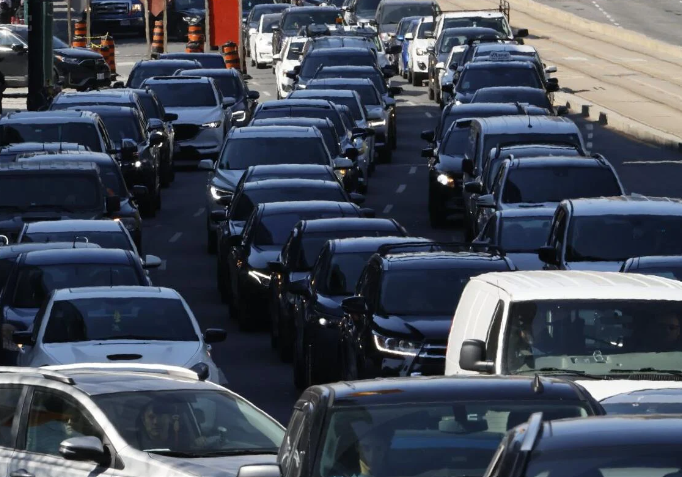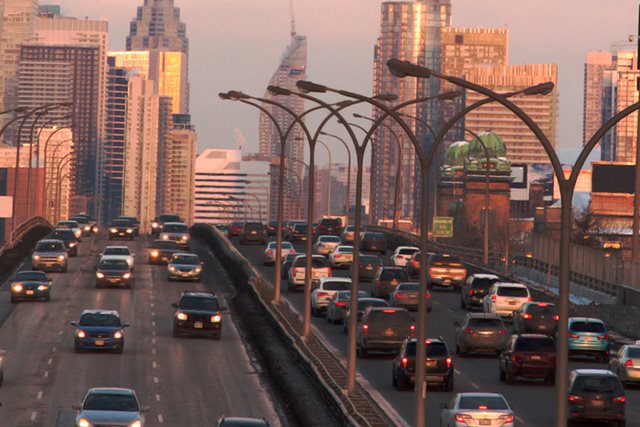
In response to our region’s persistent gridlock challenge, the Toronto Region Board of Trade struck a Congestion Task Force and Governing Council to better understand the problem and find actionable solutions. Ahead of the release of our Solutions Action Plan in February, we’ve been consulting with experts, discussing a range of strategies, and examining best practices from other cities. Congestion pricing has been a recurring theme in these conversations, and we wanted to share some of what we heard on this important topic.
Often touted as a transformative solution to urban traffic problems, congestion pricing has the ability to reduce gridlock, improve air quality, and generate revenue for public transit. It’s easy to see why it’s viewed as a silver bullet. But is it?
The truth is, congestion pricing is not one-size-fits-all—it must be carefully tailored to a city’s unique circumstances, addressing public concerns and ensuring that transit alternatives are available.
Toronto’s history with congestion pricing reflects both the promise and the controversy of this approach. While past proposals have faced significant hurdles, the growing urgency of the region’s congestion crisis makes it a topic worth revisiting—albeit with a nuanced and incremental approach.
What Is Congestion Pricing Meant to Do?
Congestion pricing puts a cost on road use during peak demand and helps manage finite road capacity, transforming roads from a “free” public resource into one that reflects their true value. This can serve several key objectives:
- Reduce Traffic Congestion: Discouraging non-essential trips during peak hours helps clear roads for those who need them most.
- Promote Behavior Change: The cost incentivizes commuters to shift to alternatives like public transit, carpooling, or off-peak travel.
- Generate Revenue: Fees collected can fund transit expansions, road maintenance, and other infrastructure improvements.
- Lower Emissions: Fewer cars on the road reduce greenhouse gas emissions and improve air quality.
Lessons from Other Cities
Cities like Stockholm, London, and Singapore have proven that congestion pricing can work, but their success didn’t happen overnight.
- Stockholm: A congestion pricing pilot in 2006 reduced traffic by 25%, improved air quality, and generated revenue for public transit. Public resistance softened once the benefits were clear, leading to permanent adoption in 2007.
- London: Introduced in 2003, London’s congestion charge reduced traffic delays and emissions while funding transit improvements. Over time, the system expanded with emissions-based pricing, demonstrating its adaptability.
- Singapore: A pioneer in congestion pricing, Singapore implemented an electronic road pricing system that adjusts fees dynamically based on traffic conditions. This approach ensures optimal road use and minimizes congestion effectively.
These cities demonstrate the importance of public buy-in, robust transit alternatives, and transparent use of revenues in ensuring success.
Cities like New York and Vancouver illustrate the challenges of turning proposals into reality, emphasizing how political, technical, and equity concerns can stall even well-studied plans.
- New York: After years of debate dating back to the 1970s, New York’s congestion pricing plan for Manhattan’s central business district was approved in 2019 but faced significant delays. Governor Kathy Hochul initially paused the program in 2024, citing economic recovery concerns, but later revived it. Now set to launch on January 5, 2025, with a base toll of $9, the plan is expected to generate $1 billion annually for public transit improvements and includes equity measures such as exemptions and subsidies for specific groups.
- Vancouver: In 2018, TransLink’s Mobility Pricing Independent Commission proposed regional point charges and distance-based pricing to tackle congestion and reduce emissions. Although not implemented, the study highlighted equity concerns and the need for political leadership, laying the groundwork for future consideration.
The Toronto Context
Toronto’s experience with congestion pricing is marked by cautious exploration and political resistance. In 2016, Mayor John Tory proposed a $2 toll on the Gardiner Expressway and Don Valley Parkway, projecting $200 million annually to fund transit and infrastructure. While the plan passed city council, it required provincial approval. Premier Kathleen Wynne ultimately rejected the proposal, citing concerns about affordability and the lack of alternative transit options.
Around the same time, the Wynne government introduced High-Occupancy Toll (HOT) lanes on select provincial highways, allowing solo drivers to pay for access to HOV lanes. Dubbed “Lexus lanes” by critics, the proposal faced backlash for seeming to favour wealthier drivers. Despite this, HOT lanes remain in operation on portions of the QEW, Highway 403, and Highway 410, offering a foundation for further exploration of targeted tolling strategies.
However, legislative developments in 2024 have introduced new hurdles. The Ontario government passed amendments banning new tolls on provincial highways, which now includes the recently uploaded Gardiner and DVP. This legislative roadblock underscores the need for creative approaches that balance political realities with pressing congestion challenges.
Moving Forward
Despite these challenges, Toronto’s current moment presents a unique opportunity to revisit congestion pricing. Provincial control of the Gardiner and DVP, combined with transformative transit projects like the Ontario Line and two-way all-day GO service, lays the groundwork for incremental approaches.
As we’ve seen in other global cities, congestion pricing can play a helpful role in alleviating traffic. However, it’s not a silver bullet—it can take years to build consensus and implement, and relies on important factors like viable transit alternatives to be successful. Beginning the conversation now can prepare the region for if and when a model could work here in the future.
-

Monika Wyrzykowska
Director, Policy, Transportation, Infrastructure, & Land Use, Toronto Region Board of Trade
Monika Wyrzykowska leads the Transportation and Infrastructure Policy portfolio at the Toronto Region Board of Trade. She joined the Board after almost a decade in the Ontario Public Service, where she served most recently as Director of Metrolinx and Agency Oversight at the Ministry of Transportation, leading governance and strategic oversight for Ontario’s transportation agencies. Monika’s work focuses on advancing policies and initiatives that drive economic growth and improve regional mobility through cross-sectoral collaboration and stakeholder engagement.

